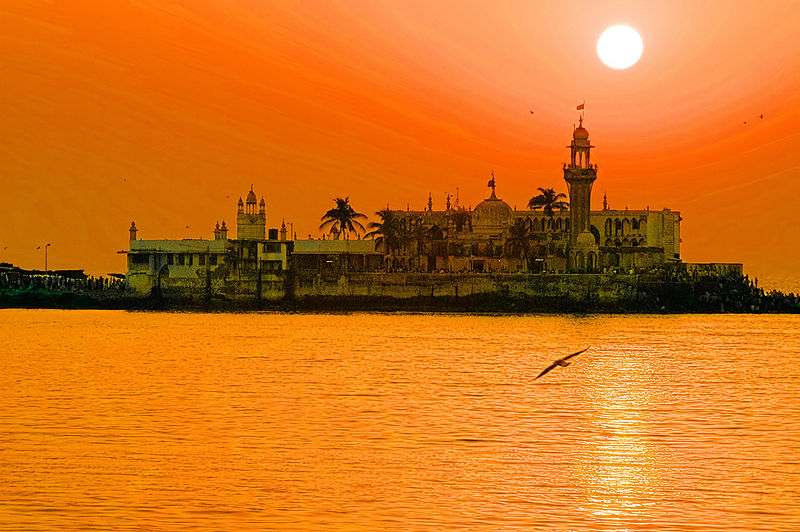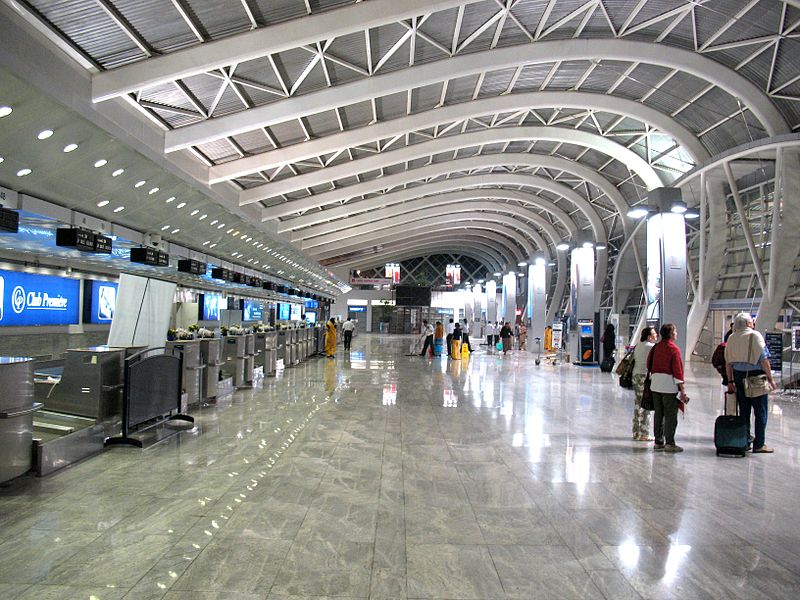Kanheri Caves served as a centre of Buddhism in Western India during ancient times

Mumbai is built on what was once an archipelago of seven islands: Bombay Island, Parel, Mazagaon, Mahim, Colaba, Worli, and Old Woman's Island (also known as
Little Colaba).
[22] Pleistocene sediments found along the coastal areas around Kandivali in northern Mumbai by archaeologist Todd in 1939 suggest that these islands were inhabited since the Stone Age.
[23] It is not exactly known when these islands were first inhabited. Perhaps at the beginning of the
Common era (2000 years ago), or even possibly earlier, they came to be occupied by the Koli fishing community.
[24] In the third century BCE, the islands formed part of the
Maurya Empire, during its expansion in the south, ruled by the Buddhist emperor,
Ashoka of Magadha.
[25] The Kanheri Caves in Borivali were excavated in the mid-third century BCE,
[26] and served as an important centre of Buddhism in Western India during ancient times.
[27] The city then was known as
Heptanesia (Ancient Greek: A Cluster of Seven Islands) to the Greek geographer Ptolemy in 150 CE.
[28] Between the second century BCE and ninth century CE, the islands came under the control of successive indigenous dynasties: Satavahanas, Western Kshatrapas, Abhiras, Vakatakas, Kalachuris, Konkan Mauryas, Chalukyas and Rashtrakutas,[29] before being ruled by the Silhara dynasty from 810 to 1260.[30] Some of the oldest edifice in the city built during this period are, Jogeshwari Caves (520 to 525),[31] Elephanta Caves (sixth to seventh century),[32] Walkeshwar Temple (10th century),[33] and Banganga Tank (twelfth century).[34] King Bhimdev founded his kingdom in the region in the 12th or 13th century, and established his capital in Mahikawati (present day Mahim).[35] The Pathare Prabhus, one of the earliest known settlers of the city, were brought to Mahikawati from Saurashtra in Gujarat by Bhimdev.[36] The Muslim rulers of Gujarat annexed the islands in 1348.[37] They were later governed by the Gujarat Sultanate from 1391 to 1534. The Sultanate's patronage led to the construction of many mosques, prominent being the Haji Ali Dargah in Mahim, built in honour of the Muslim saint Haji Ali in 1431.[38] From 1429 to 1431, the islands were a source of contention between the Gujarat Sultanate and the Bahamani Sultanate of Deccan.[39][40] In 1493, Bahadur Khan Gilani of the Bahamani Sultanate attempted to conquer the islands, but was defeated.[41]
The
Haji Ali Dargarh was built in 1431, when Mumbai was under the Gujarat Sultanate

The Mughal Empire, founded in 1526, was the dominant power in the Indian subcontinent during the mid-16th century.[42] Growing apprehensive of the power of the Mughal emperor Humayun, Sultan Bahadur Shah of the Gujarat Sultanate was obliged to sign the Treaty of Bassein with Portuguese settlers on 23 December 1534. According to the treaty, the seven islands of Bombay, the nearby strategic town of Bassein and its dependencies were offered to the Portuguese. The territories were later surrendered on 25 October 1535.[43] The Portuguese were actively involved in the foundation and growth of their Roman Catholic religious orders in Bombay.[44] Some of the oldest Catholic churches in the city such as the St. Michael's Church at Mahim (1534),[45] St. John the Baptist Church at Andheri (1579),[46] St. Andrew's Church at Bandra (1580),[47] and Gloria Church at Byculla (1632),[48] date from the Portuguese era. On 11 May 1661, the marriage treaty of Charles II of England and Catherine of Braganza, daughter of King John IV of Portugal, placed the islands in possession of the British Empire, as part of Catherine's dowry to Charles.[49] However, Salsette, Bassein, Mazagaon, Parel, Worli, Sion, Dharavi, and Wadala still remained under Portuguese possession. From 1665 to 1666, the British managed to acquire Mahim, Sion, Dharavi, and Wadala.[50]
These islands were in turn leased to the British East India Company in 1668 for a sum of £10 per annum by the Royal Charter of 27 March 1668.[51] The population quickly rose from 10,000 in 1661, to 60,000 in 1675.[52] The islands were subsequently attacked by Yakut Khan, the Siddi admiral of the Mughal Empire, in October 1672,[53] Rickloffe van Goen, the Governor-General of Dutch India on 20 February 1673,[54] and Siddi admiral Sambal on 10 October 1673.[53] In 1687, the British East India Company transferred its headquarters from Surat to Bombay. The city eventually became the headquarters of the Bombay Presidency.[55] Following the transfer, Bombay was placed at the head of all the Company's establishments in India.[56] Towards the end of the 17th century, the islands again suffered incursions from Yakut Khan in 1689–90.[57] The Portuguese presence ended in Bombay when the Marathas under Peshwa Baji Rao I captured Salsette in 1737, and Bassein in 1739.[58] By the middle of the 18th century, Bombay began to grow into a major trading town, and received a huge influx of migrants from across India.[59] Later, the British occupied Salsette on 28 December 1774. With the Treaty of Surat (1775), the British formally gained control of Salsette and Bassein, resulting in the First Anglo-Maratha War.[60] The British were able to secure Salsette from the Marathas through the Treaty of Purandar (1776),[61] and later through the Treaty of Salbai (1782), signed to settle the outcome of the First Anglo-Maratha War.[62]
Ships in
Bombay Harbour (c. 1731). Bombay emerged as a significant trading town during the mid-18th century

From 1782 onwards, the city was reshaped with large-scale civil engineering projects aimed at merging all the seven islands into a single amalgamated mass. This project, known as the Hornby Vellard, was completed by 1784.
[63] In 1817, the British East India Company under Mountstuart Elphinstone defeated Baji Rao II, the last of the Maratha
Peshwa in the
Battle of Kirkee.
[64] Following his defeat, almost the whole of the Deccan came under British suzerainty, and were incorporated in Bombay Presidency. The success of the British campaign in the Deccan witnessed the freedom of Bombay from all attacks by native powers.
[65] By 1845, the seven islands were coalesced into a single landmass by the Hornby Vellard project.
[66] On 16 April 1853, India's first passenger railway line was established, connecting Bombay to the neighbouring town of Thane.
[67] During the American Civil War (1861–1865), the city became the world's chief cotton trading market, resulting in a boom in the economy that subsequently enhanced the city's stature.
[68] The opening of the Suez Canal in 1869 transformed Bombay into one of the largest seaports on the Arabian Sea.
[69] In September 1896, Bombay was hit by a
bubonic plague epidemic where the death toll was estimated at 1,900 people per week.
[70] About 850,000 people fled Bombay and the textile industry was adversely affected.
[71] As the capital of the Bombay Presidency, it witnessed the Indian independence movement, with the Quit India Movement in 1942 and the
The Royal Indian Navy Mutiny in 1946 being its most notable events.
[72][73] After India's independence in 1947, the territory of the Bombay Presidency retained by India was restructured into Bombay State. The area of Bombay State increased, after several erstwhile princely states that joined the Indian union were integrated into Bombay State. Subsequently, the city became the capital of Bombay State.
[74] In April 1950, Greater Bombay District came into existence with the merger of
Bombay Suburbs of Salsette and
Bombay City for the purposes of municipal administration.

In the Lok Sabha discussions in 1955, the Congress party demanded that the city be constituted as an autonomous city-state.[76] In 1956, the States Reorganisation Committee recommended a bilingual state for Maharashtra–Gujarat with Bombay as its capital. Bombay Citizens' Committee, an advocacy group comprising of leading Gujarati industrialists lobbied for Bombay's independent status.[77] In the 1957 elections, the Samyukta Maharashtra movement opposed these proposals, and insisted that Bombay be declared the capital of Maharashtra.[78] Following protests by the movement in which 105 people were killed by police at Flora Fountain, Bombay State was reorganised on linguistic lines on 1 May 1960.[79] Gujarati-speaking areas of Bombay State were partitioned into the state of Gujarat.[80] Maharashtra State with Bombay as its capital was formed with the merger of Marathi-speaking areas of Bombay State, eight districts from Central Provinces and Berar, five districts from Hyderabad State, and numerous princely states enclosed between them.[81] As a memorial to the martyrs of the Samyukta Maharashtra movement, Flora Fountain was renamed as Hutatma Chowk (Martyr's Square), and a memorial was erected.[82]
The following decades saw massive expansion of the city and its suburbs. In the late 1960s, Nariman Point and Cuffe Parade were reclaimed and developed.[83] The Bombay Metropolitan Region Development Authority (BMRDA) was set up on 26 January 1975 by the Government of Maharashtra as an apex body for planning and co-ordination of development activities in the Bombay metropolitan region.[84] In August 1979, a sister township of New Bombay was founded by City and Industrial Development Corporation (CIDCO) across Thane and Raigad districts to help the dispersal and control of Bombay's population.[85] The Jawaharlal Nehru Port, which currently handles 55–60% of India's containerized cargo, was commissioned on 26 May 1989 at Nhava Sheva with a view to de-congest Bombay Harbour and to serve as a hub port for the city.[86]
The past two decades have seen an increase in violence in the hitherto largely peaceful city. Following the demolition of the Babri Masjid in Ayodhya, the city was rocked by the Hindu-Muslim riots of 1992–93 in which more than 1,000 people were killed.[87] On 12 March 1993, a series of 13 co-ordinated bombings at several city landmarks by Islamic extremists and the Bombay underworld resulted in 257 deaths and over 700 injuries.[88] In 2006, 209 people were killed and over 700 injured when seven bombs exploded on the city's commuter trains.[89] In 2008, a series of ten coordinated attacks by armed terrorists for three days resulted in 173 deaths, 308 injuries, and severe damage to several important buildings.[90] Despite these incidents, Mumbai remains a major trading centre that has evolved to become a global financial hub.[91] For several decades it has been the site for the concentration of India's financial services, and a focus for both infrastructure development and private investment.[92] From being an ancient fishing community and a colonial centre of trade, Mumbai has become the subcontinent's largest port and home of the world's most prolific film industry























 Mumbai's culture is a blend of traditional festivals, food, music, and theatres. The city offers a cosmopolitan and diverse lifestyle with a variety of food, entertainment and night life, available in a form and abundance comparable to that in other world capitals. Mumbai's history as a major trading centre has led to a diverse range of cultures, religions and cuisines coexisting in the city. This unique blend of cultures is due to the migration of people from all over India since the British period.
Mumbai's culture is a blend of traditional festivals, food, music, and theatres. The city offers a cosmopolitan and diverse lifestyle with a variety of food, entertainment and night life, available in a form and abundance comparable to that in other world capitals. Mumbai's history as a major trading centre has led to a diverse range of cultures, religions and cuisines coexisting in the city. This unique blend of cultures is due to the migration of people from all over India since the British period.


